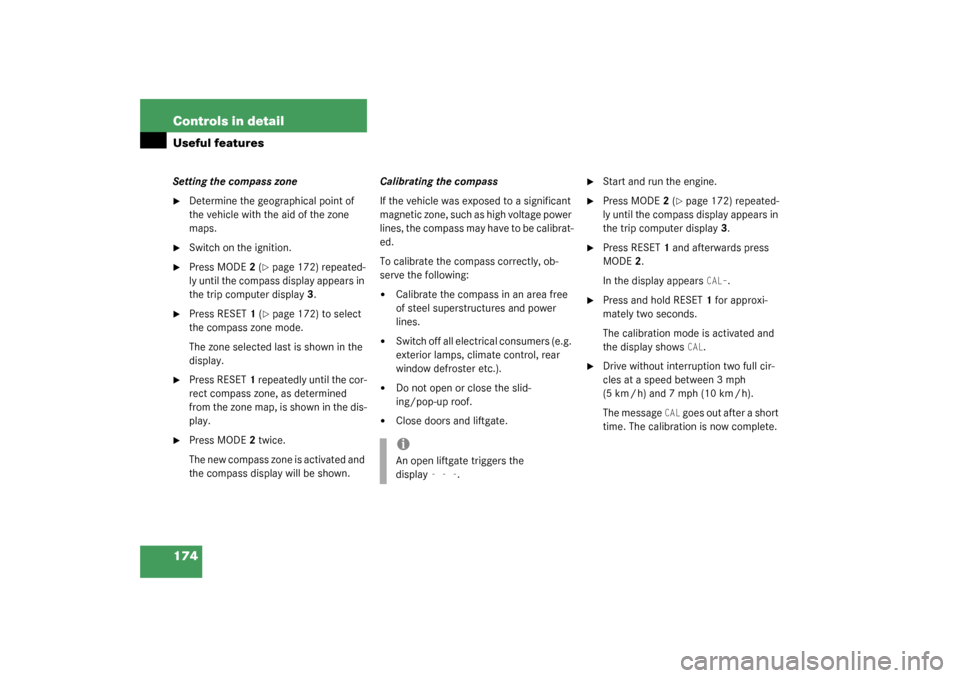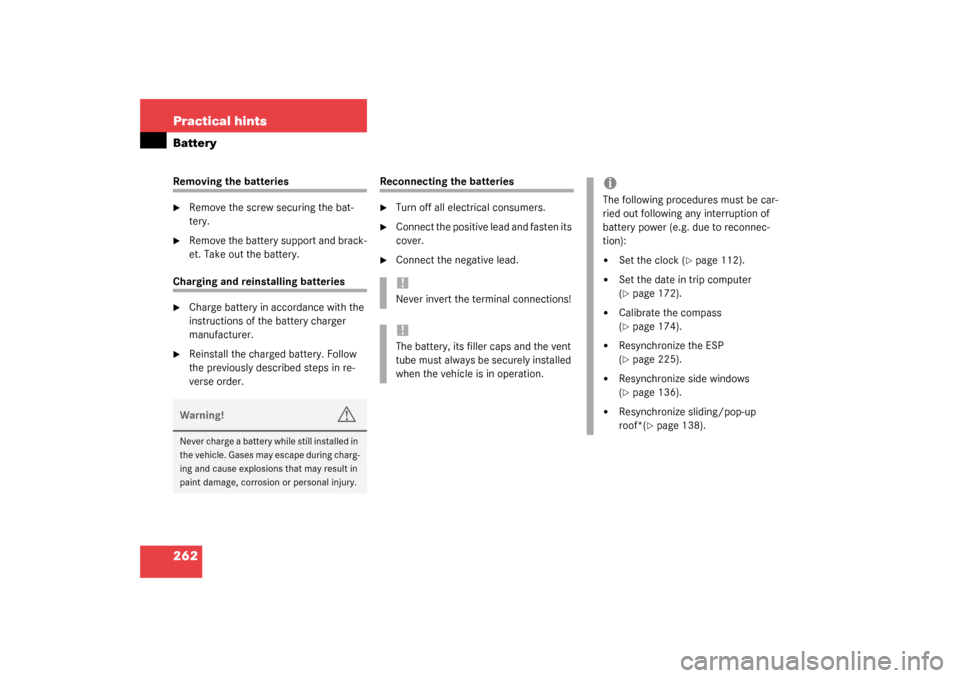Page 174 of 321

174 Controls in detailUseful featuresSetting the compass zone�
Determine the geographical point of
the vehicle with the aid of the zone
maps.
�
Switch on the ignition.
�
Press MODE2 (
�page 172) repeated-
ly until the compass display appears in
the trip computer display3.
�
Press RESET1 (
�page 172) to select
the compass zone mode.
The zone selected last is shown in the
display.
�
Press RESET1 repeatedly until the cor-
rect compass zone, as determined
from the zone map, is shown in the dis-
play.
�
Press MODE2 twice.
The new compass zone is activated and
the compass display will be shown.Calibrating the compass
If the vehicle was exposed to a significant
magnetic zone, such as high voltage power
lines, the compass may have to be calibrat-
ed.
To calibrate the compass correctly, ob-
serve the following:
�
Calibrate the compass in an area free
of steel superstructures and power
lines.
�
Switch off all electrical consumers (e.g.
exterior lamps, climate control, rear
window defroster etc.).
�
Do not open or close the slid-
ing/pop-up roof.
�
Close doors and liftgate.
�
Start and run the engine.
�
Press MODE2 (
�page 172) repeated-
ly until the compass display appears in
the trip computer display3.
�
Press RESET1 and afterwards press
MODE2.
In the display appears
CAL–
.
�
Press and hold RESET1 for approxi-
mately two seconds.
The calibration mode is activated and
the display shows
CAL
.
�
Drive without interruption two full cir-
cles at a speed between 3 mph
(5 km / h) and 7 mph (10 km / h).
The message
CAL
goes out after a short
time. The calibration is now complete.
iAn open liftgate triggers the
display
---
.
Page 186 of 321

186 OperationDriving instructionsOff-road driving
Read this chapter carefully before you be-
gin off-road travel.
Familiarize yourself with the vehicle char-
acteristics and gear changing before you
attempt any difficult terrain off-road driv-
ing. We recommend that you start out with
easy off-road travel.Special driving features for off-road
driving
The following driving features are available
for specific kind of operation:
�
LOW RANGE mode (
�page 118)
�
LOW RANGE – ABS (
�page 72)
�
LOW RANGE – 4-ETS (
�page 74)
�
LOW RANGE – ESP (
�page 76)
Off-road driving rules
Engage the LOW RANGE mode before driv-
ing under off-road conditions
(
�page 118).
Fasten items being carried as securely as
possible (
�page 139).
Warning!
G
Drive slowly in unknown terrain. This will
make it easier to recognize unexpected ob-
stacles and avoid damage to the vehicle.
To help avoid the vehicle rolling over, never
turn it around on steep inclines. If the vehi-
cle cannot complete the attempted climb,
back it down in reverse gear.
Do not drive along the side of a slope (dan-
ger of vehicle rollover). The vehicle might
otherwise rollover. If in doing so the vehicle
begins to show a tendency to roll, immedi-
ately steer into a line of gravity (straight up
or downhill).
Never let the vehicle roll backwards in idle
or when the clutch is disengaged. You may
lose control of the vehicle if you use only the
service brake.
Warning!
G
Sand, dirt, mud and other material having
friction property can cause exceptional wear
and tear as well as brake failure.
Have the brakes checked for dirt build-up
and cleaned. There is otherwise a risk that
full braking power may not be available in an
emergency.
iWe recommend keeping doors, liftgate,
windows, and sliding/pop-up roof*
closed whenever driving in off-road
mode.
Page 218 of 321

218 OperationVehicle careYour vehicle has been treated at the facto-
ry with a wax-base rustproofing in the body
cavities which will last for the lifetime of
the vehicle. Post-production treatment is
neither necessary nor recommended by
Mercedes-Benz because of the possibility
of incompatibility between materials used
in the production process and others ap-
plied later.
We have selected car-care products and
compiled recommendations which are
specially matched to our vehicles and
which always reflect the latest technology.
You can obtain Mercedes-Benz approved
car-care products at your authorized
Mercedes-Benz Light Truck Center.Scratches, corrosive deposits, corrosion or
damage due to negligent or incorrect care
cannot always be removed or repaired with
the car-care products recommended here.
In such cases it is best to seek aid at your
authorized Mercedes-Benz Light Truck
Center.
The following topics deal with the cleaning
and care of your vehicle and give important
“how-to” information as well as references
to Mercedes-Benz approved car-care prod-
ucts.
Additional information can be found in the
booklet entitled “Vehicle Care Guide”.Power washer
When using a power washer for cleaning
the vehicle, always observe manufactur-
er’s operating instructions.
Tar stains
Quickly remove tar stains before they dry
and become more difficult to remove. A tar
remover is recommended.
!Never use a round nozzle to power
wash tires. The intense jet of water can
result in damage to the tire.
Always replace a damaged tire.
Always keep the jet of water moving
across the surface. Do not aim directly
at electrical parts, electrical connec-
tors, seals, or other rubber parts.
Page 246 of 321
246 Practical hintsOpening/closing in an emergency
Opening/closing in an emergencySliding/pop-up roof*
The sliding/pop-up roof drive is located
behind the cover between the front interior
lamps.
You can open or close the sliding/pop-up
roof manually should an electrical malfunc-
tion occur.
1Hexagon drive hole
2Crank
3Cover
�
Pry off cover3 using a flat blade srew-
driver.
�
Obtain crank2 (supplied with vehicle)
and insert in hexagon drive1
�
Turn crank2 clockwise to:�
slide roof closed
�
raise roof at the rear
�
Turn crank2 counterclockwise to:�
slide roof open
�
lower roof at the rear
The sliding/pop-up roof must be synchro-
nized if it has been operated manually
(
�page 138).iPush crank2 upward while turning it,
to disengage the electric motor.
Page 261 of 321

261 Practical hints
Battery
Battery
The battery is located in the engine com-
partment on the right-hand side.
Disconnecting the battery�
Turn off all electrical consumers.
�
Open the hood (
�page 202).
�
Disconnect the battery negative lead.
�
Remove the cover from the positive ter-
minal.
�
Disconnect the battery positive lead.
Warning!
G
Failure to follow these instructions can re-
sult in severe injury or death.
Never lean over batteries while connecting,
you might get injured.
Battery fluid contains sulfuric acid. Do not
allow this fluid to come in contact with eyes,
skin or clothing. In case it does, immediately
flush affected area with water and seek
medical help if necessary.
A battery will also produce hydrogen gas,
which is flammable and explosive. Keep
flames or sparks away from battery, avoid
improper connection of jumper cables,
smoking etc.
!Never loosen or detach battery termi-
nal clamps while the engine is running
or the key is in the steering lock. Other-
wise the alternator and other electronic
components could be severely dam-
aged.
Have the battery checked regularly by
an authorized Mercedes-Benz Light
Truck Center.
Refer to Service Booklet for mainte-
nance intervals or contact your autho-
rized Mercedes-Benz Light Truck
Center for further information.Warning!
G
Do not place metal objects on the battery as
this could result in a short circuit.
Use leak-proof battery only to avoid the risk
of acid burns in the event of an accident.
Warning!
G
With a disconnected battery�
y o u w i l l n o l o n g e r b e a b l e t o t u r n t h e k e y
in the steering lock
�
the selector lever will remain locked in
positionP
Page 262 of 321

262 Practical hintsBatteryRemoving the batteries�
Remove the screw securing the bat-
tery.
�
Remove the battery support and brack-
et. Take out the battery.
Charging and reinstalling batteries�
Charge battery in accordance with the
instructions of the battery charger
manufacturer.
�
Reinstall the charged battery. Follow
the previously described steps in re-
verse order.
Reconnecting the batteries�
Turn off all electrical consumers.
�
Connect the positive lead and fasten its
cover.
�
Connect the negative lead.
Warning!
G
Never charge a battery while still installed in
the vehicle. Gases may escape during charg-
ing and cause explosions that may result in
paint damage, corrosion or personal injury.
!Never invert the terminal connections!!The battery, its filler caps and the vent
tube must always be securely installed
when the vehicle is in operation.
iThe following procedures must be car-
ried out following any interruption of
battery power (e.g. due to reconnec-
tion):�
Set the clock (
�page 112).
�
Set the date in trip computer
(�page 172).
�
Calibrate the compass
(�page 174).
�
Resynchronize the ESP
(�page 225).
�
Resynchronize side windows
(�page 136).
�
Resynchronize sliding/pop-up
roof*(
�page 138).
Page 283 of 321
283 Technical data
Weights
Weights
Roof load max.
220 lb (100 kg)
Page 302 of 321

302 IndexCargo floor plates 144
Installing 144
Removing 144
Storing 144
Cargo tie-down rings 140
Catalytic converter 198
CD-changer* 238
Center console 27
Lower part 28
Upper part 27
Central locking
Automatic 89
From inside 89
Switch 90
Unlocking from inside 89, 90
Central locking switch 90
Certification label 276
Charge indicator lamp 233
Charging
Vehicle battery 262
Chart
Fuses 271
CHECK ENGINE malfunction indicator
lamp 232
Checking
Coolant level 201, 206Oil level 201, 203
Tire inflate pressure 201
Vehicle lighting 201
Checking weights
Trailer and vehicle 193
Checklist
Off-road driving 187
Returning from off-road driving 191
Child safety 63
Airbags 56
Infant and child restraint systems 54,
60, 63
LATCH child seat mounts 68
Child safety switch see Blocking of rear
door window operation 69
Cigarette lighter
Front center console 156
Cleaning
Cup holder 221
Gear selector lever 221
Hard plastic trim items 221
Headlamps 121
Headliner 221
Instrument cluster 221
Leather upholstery 222
Light alloy wheels 221MB Tex upholstery 222
Plastic and rubber parts 222
Seat belts 221
Steering wheel 221
Windows 220
Windshield 48
Wiper blades 220
Cleaning and care of the vehicle see
Vehicle care 217
Clock 26, 112
Closing
Glove box 152
Hood 203
Liftgate 88
Rear quarter windows* 136
Side windows 135
Sliding/pop-up roof 246
Sliding/pop-up roof* 137
Closing sliding/pop-up roof
In an emergency 246
Cockpit 22, 293
Combination switch 102
High beam flasher 47, 102
Turn signals 47
Windshield wipers 47